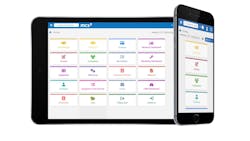Josh Lewis, president, MCS Rental Software, talks about customer feedback, having a single-solution login, intelligent equipment, and more.
What is new in your software and technology?
Josh Lewis: Our software continues to improve, thanks largely to customer ideas and feedback through our MCS User Group. Our users share their ideas and then vote on changes, which leads to incredible improvements.
Some of the latest updates include a revamped Resource Mobile app for iOS and Android. Now, delivery drivers and mobile techs can use a phone or tablet (instead of paper) to capture pictures, signatures, notes, and more. Meanwhile, all other teams can see completed and upcoming tasks in real-time.
Another exciting addition is our new equipment scanning feature, eScan. By scanning the QR code on the machine, both staff and customers can access important documents such as user manuals, specifications, and certifications in one digital place.
Plus, we’ve expanded our Telematics Hub to include Geoforce and Samsara, two of the industry’s top providers, and further expanding our list of integrated solutions.
What effects has AI had on your software and technology and what potential do you see going forward?
AI continues to be a hot topic among our tech teams. Integrating AI into our software is like taking automation to the next level. We’re talking about improved reporting, powerful business intelligence, and predictive analytics for our customers to run their business. We’re also looking at opportunities to enhance the overall experience for their customers. The possibilities seem limitless. However, we cannot forget what truly makes our rental software successful: it’s a people-first solution. Rushing to incorporate buzzword technology could risk compromising the entire user experience.
How important is integration of all of your systems?
Rental companies tend to focus on day-to-day operations and do whatever they can to keep things running smoothly. If they’re not careful, they can implement multiple workaround solutions, which leads to a growing list of systems and logins to manage. The real selling point of our ERP rental solution is having all data streams and processes in one place—a single solution login instead of juggling dozens at a time. Our vision is to provide a comprehensive rental solution that integrates with other non-rental, best-in-class solutions. It’s crucial.
What new trends in technology do you expect in the foreseeable future?
The big trend on the horizon (in addition to AI) is the growing demand for automation. Effective automation of processes and services can yield tremendous benefits to a rental operation. Rental companies will need to automate internal processes wherever possible because the new workforce expects smart digitalization across the board.
Another exciting development is intelligent equipment—think self-driving machines. Imagine needing a machine to dig a precise depth in a specific spot of land. Advanced machinery could be programmed to handle that task flawlessly. If this becomes the industry standard, rental companies won’t just provide the equipment; they’ll also offer the service.
What are the most important contributions telematics makes to a rental company and how challenging is it to integrate telematics with a rental management operating system?
Telematics brings tremendous visibility to rental businesses. Yes, it provides a bird’s-eye view of rental assets, making it easy to locate equipment quickly. That translates to faster response times and reduced downtime. Telematics also helps keep an eye on unauthorized equipment use, resulting in greater accuracy in billing for overage hours and preventing maintenance issues due to overuse.
In the future, we see an opportunity to capture error codes and quickly notify personnel both internally and at the job site. This time savings could be the difference between a quick repair and an overhaul repair.
Integrating telematics should be easy to achieve and instantly beneficial. Take our comprehensive Telematics Hub, for instance. Our users connect with one or more of the nearly two dozen providers. Now instead of logging into multiple providers, our users see and report on consolidated data from multiple providers in a single platform.
About the Author
Michael Roth
Editor
Michael Roth has covered the equipment rental industry full time for RER since 1989 and has served as the magazine’s editor in chief since 1994. He has nearly 30 years experience as a professional journalist. Roth has visited hundreds of rental centers and industry manufacturers, written hundreds of feature stories for RER and thousands of news stories for the magazine and its electronic newsletter RER Reports. Roth has interviewed leading executives for most of the industry’s largest rental companies and manufacturers as well as hundreds of smaller independent companies. He has visited with and reported on rental companies and manufacturers in Europe, Central America and Asia as well as Mexico, Canada and the United States. Roth was co-founder of RER Reports, the industry’s first weekly newsletter, which began as a fax newsletter in 1996, and later became an online newsletter. Roth has spoken at conventions sponsored by the American Rental Association, Associated Equipment Distributors, California Rental Association and other industry events and has spoken before industry groups in several countries. He lives and works in Los Angeles when he’s not traveling to cover industry events.
